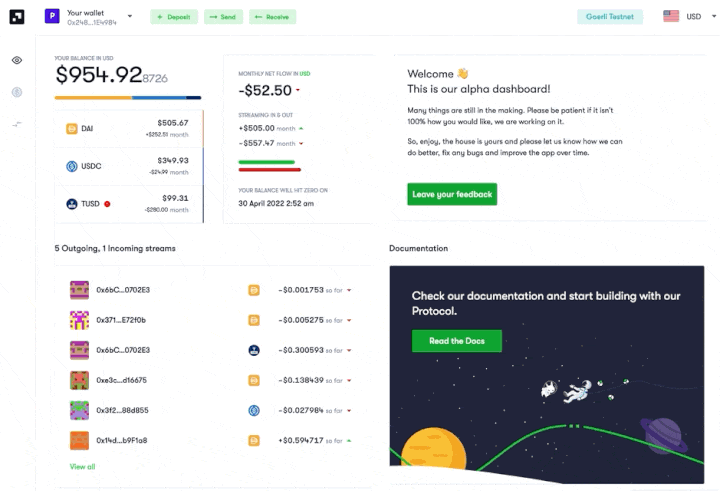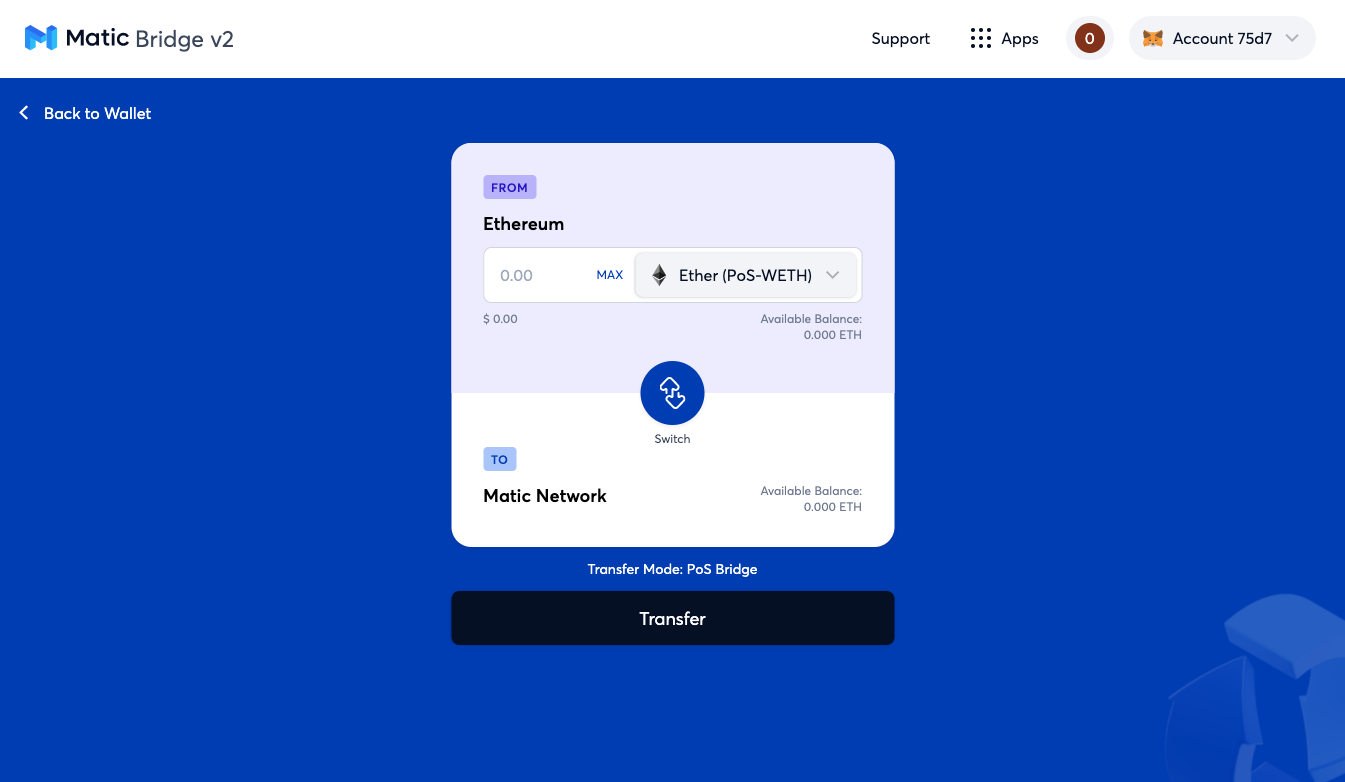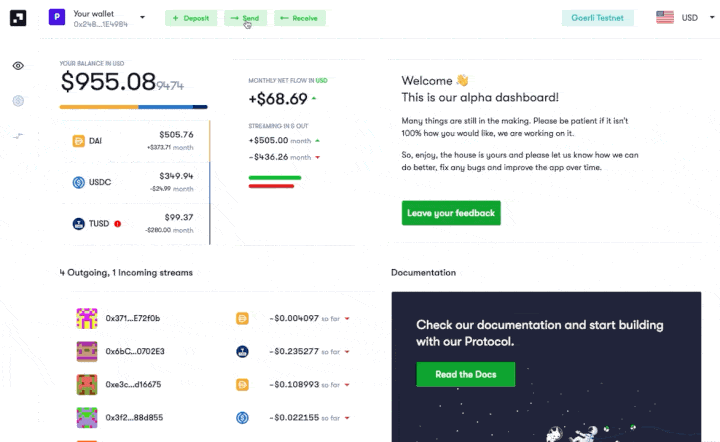How to stream money

Dear Bankless Nation,
Who doesn’t want to get paid in real-time?
Streaming money has always been one of those uses cases that crypto natives always dreamed of. We’ve written about this before.
Imagine DAOs that are able to redirect all their income streams to contributors as it comes in?
Or an NFT that streams royalty payments to holders?
Or DCA’ing into an Set index position every second?
The world that unlocks when we transition away from our current archaic 9-5 banking system to 24/7 finance will be mind blowing.
Forget getting paid once every other week. How about once every second?
Access to your money in real-time, right when you earn it.
When we wrote about money streaming in 2019 the timing wasn’t right. No layer 2. No breakthrough protocol design. DeFi in its infancy.
I think crypto’s ready this time around.
Superfluid is a new money streaming building block for DeFi that developers can use to build new applications. Seriously impressive.
The banks have no idea what’s coming for them.
Let’s level up on money streaming.
- RSA
Tactic Tuesday
Guest Writer: Michele D’Aliessi, Co-founder and COO at Superfluid
How to stream money to anyone
Superfluid is a new DeFi protocol that enables automated value transfer via money streaming and programmable cash flows.
By upgrading any ERC20 tokens via a wrapping process, you can stream the assets on chain with a single transaction to start, edit and close a stream. The streams run continuously without requiring any gas and all tokens are automatically transferred to the recipient wallet. You can even see the balance ticking up in real-time directly on your Metamask!
This Ethereum-powered protocol is an innovative modular design space for developers to build new blockchain applications leveraging automated transfer of value over any amount of time. The core smart contracts are also extensible so that new, key features can be added in the future.
At the moment the core features built on Superfluid include:
Money Streaming: send endless streams without locking your tokens upfront, the stream will keep flowing until you stop it or run out of funds. Receivers will get the tokens directly in their wallet, no withdrawal required.
Instant Distributions: distribute rewards from one wallet to 1000s of recipients in a single transaction.
SuperApps: build whole new applications with custom logic, enabling a wide range of new applications like:
- DAOs that redirect all incoming streams to reward their members and contributors 🏦
- An NFT automatically entitling the holder to an ongoing reward 💰
- Automated DeFi strategies, pooling streamed investments from users🤖
- Dollar Cost Averaging: send a stream of DAI to accumulate ETH 💱
The idea of payment streams is a long-sought after crypto primitive and Superfluid takes it to the next level. This tactic will teach you everything you need to know about Superfluid and how you can leverage its capabilities to your benefit.
- Goal: Send your first stream on Ethereum side-chains
- Skill: Intermediate
- Effort: 10 mins
- ROI: Automate your recurring transactions, be in control of all incoming and outgoing streams!
What you need to know about Superfluid
As a Bankless reader, you probably know about the complexity of managing recurring transactions on blockchain networks.
You may have experienced this personally if you decided to pay for services using stablecoins: the service provider asks you to process a transaction every month and you need to spend a few minutes to unlock your wallet, set the right amount, broadcast the transaction, wait for confirmation, pay gas fees and make sure you do all that safely (and without any mistakes!).
Ideally, we would like to have the same seamless experience of paying via credit card, where you input your card information once and the payments are processed automatically on your behalf every month. The problem is that many blockchain users want to be in full control of their funds and don’t want to grant third parties the ability to pull tokens from their wallet at will, as that is both an uncomfortable feeling and a security risk.
Superfluid Protocol allows you to have a credit card-like experience in Web3 by enabling the very first push payment solution for recurring transactions.
You simply open a stream of tokens to the recipient (with one transaction on-chain), and it will run for as long as you want, so long as you have funds in your wallet. Set and forget, no more monthly transactions required!
This means any service provider can request a stream of crypto dollars that will remove all the friction (and cognitive effort) for both the sender and the recipient, automating everything in the background, drastically simplifying the user experience of Web3.

The Birth of Real-Time Finance
But wait, there's even more. Funds aren’t locked and can still move freely between accounts. This means that if you are receiving a stream of tokens, you can forward it on to another recipient in any amount of your choice, and so can the recipient, effectively creating a network of interconnected wallets exchanging value in real time! This is what we call Real Time Finance, a network of interconnected players able to transfer value to one another in real time with no intermediaries.
This fluid streaming is only one of the core features of Superfluid. The protocol is designed with a modular framework to empower developers to build with new money legos in DeFi. You can see Superfluid as a toolbox for software developers to create a whole new layer of decentralized applications that leverage automated, continuous value transfer over any amount of time.
Programmable Money 2.0
Ever dreamed of DAOs that can handle multiple incoming streams of value and reward their contributors with a portion of these streams? Or NFTs for music rights with royalties paid every second to the NFT holder? Not only this is possible, but is being built as we speak.
Last week during the NFT Hack hackathon, a new referral marketing platform called Drip was born. They substantially transform referral marketing with commissions paid by diverting a percentage of the customer stream directly to the referrer. This enables full transparency and removes any payment delay for those who make the referrals. The stream of commissions is tokenized via an NFT, so it can be publicly traded on the market 🤯
Another project called Creaton is using Superfluid Protocol to build a Web3 version of Patreon, allowing creators to be supported financially by their community while enabling higher engagement.
The team at Reality Cards, a time-based prediction market, rebuilt their core smart contract logic over a single weekend by deferring all the complexity and heavy-lifting to Superfluid smart contracts, allowing them to focus on the higher level logic of their dApp.
The real power of Superfluid Protocol lies in this modular smart contract framework that handles the complexity of transferring value over time, enabling developers (and blockchain businesses, DAO, open source projects) to build and deploy apps quickly with this financial primitive.
It’s a whole new design space for DeFi and the broader blockchain ecosystem!
If you are a developer and want to build with Superfluid, our documentation is a great place to start. Join the conversation on our Discord and we will help you as much as we can.
How to use Superfluid to stream money
Sending a Superfluid stream on Polygon (formerly Matic) is very easy and should take just one minute.
However, if this is your first time using the Polygon network, you need to port some of your tokens from Ethereum mainnet before you can effectively send your first stream. So if you don’t have any tokens on Polygon read on, otherwise just skip down to “Time to send your first stream!”.
Fortunately, to migrate tokens to Polygon, all you will need is Metamask and some Ether/Matic to cover the transaction fees.
Getting your tokens on Polygon
At the moment you can stream ETH, DAI, or MATIC on Polygon. Feel free to choose which token you would like to stream based on what you already have in your wallet. If you don’t have any of these, MATIC is probably the easiest option as you can buy them directly with fiat on many exchanges like Coinbase or Ramp.network and transfer them directly to your wallet.
If you already have MATIC on Polygon, go ahead and skip this section and read from “Time to send your first stream!”.
If you would like to port ETH, DAI or MATIC from Ethereum mainnet to Polygon, you can do so by using their bridge.
Visit the Matic Network Bridge and connect your Metamask wallet selecting Ethereum mainnet. It will ask you to sign a transaction in order to log in.
The interface should be asking how much Ether you want to port from Ethereum mainnet to Polygon and input a number you are comfortable with (remember to leave some ETH in your wallet to pay for the transaction gas fee!!).

You should see “Transfer Mode: PoS bridge” just above the black Transfer button, if not please set it to “PoS bridge”.
Click “Transfer” as soon as you are ready and confirm all the way until the transaction is processed and confirmed. It might take a while due to the high demand of the Ethereum network. You’ll want to keep an eye on the transfer progress so don’t close the browser tab quite yet!
Once the transfer is completed, you can switch your wallet network to Polygon (Matic). On Metamask you can do that on the very top where it says “Ethereum mainnet”. If you don’t see Matic/Polygon among the selection options, you can add it very easily by clicking the “Matic” button on this page.
If you already have Matic as a selection option on Metamask, please add this RPC instead.
After switching to the Matic network, you can check your wallet balance here. You should also have received a small amount of $MATIC that should be more than enough to pay for gas fees on Polygon in order to open a stream.
Time to send your first stream!
Head to the Superfluid Dashboard and connect your wallet to the Matic network, when asked to deposit tokens during the onboarding process, deposit the amount of ETH, DAI or MATIC that you are comfortable with and wait for the transaction confirmation.
This isn’t an actual “deposit”, it’s just wrapping your tokens and sending the wrapped version directly to your wallet. Superfluid doesn’t handle any of your funds, they are always available in your wallet.

Well done!
Now you can start your stream. Hit “Send” on the top menu bar, and enter the address of a friend or another wallet you own. Then decide how much you want to send per month, hour, day or second and hit “Start streaming” - your wallet will ask you to confirm the transaction. Once the transaction is processed your stream will start and you can see it appear on the dashboard!
Congrats! You are now streaming money on Polygon with Superfluid 🎉
You can share the details of your stream on Twitter too! There’s a dedicated sharing link that you can find by clicking on the stream and hitting the “Share stream details” in the bottom right! Post it and we’ll share it on Twitter - let’s get the bankless nation streaming money!
Closing Thoughts
Superfluid is a new financial primitive that unlocks the potential to transfer value to anyone, anywhere, in real-time. Better yet, streaming money is only one basic application of the protocol. Developers can use Superfluid to build new, powerful financial apps with it. The future of finance with this primitive is limitless.
If you’re interested in learning more about Superfluid or building on the protocol, feel free to join our official Discord or follow us on Twitter for news & updates!
P.S. We are auctioning 5 unique NFTs to commemorate the launch of Superfluid Protocol on xDAI and Polygon networks. The auction is currently running on Polygon so now that you know how to send a stream don’t miss the opportunity to get one of these rare NFTs! 🏆
Action steps
- Stream money on Superfluid
- Explore how to use Polygon as a scaling solution (formerly Matic)
- Participate in the Superfluid NFT Auction!
Author Bio
Michele D’Aliessi is co-founder and COO at Superfluid, a new DeFi primitive that enables value transfer automation via money streaming and programmable cashflows.